
“Would you believe me if I told you there was something inside that rock we found tonight? – something that could wipe out this whole town?”
Director: Irvin S. Yeaworth Jr and Russell S. Doughten Jr (uncredited)
Starring: Steve McQueen, Aneta Corsaut, Earl Rowe, Stephen Chase, Olin Howlin, John Benson, Elbert Smith, Hugh Graham, Robert Fields, James Bonnet, Anthony Franke, Lee Payton, George Karas, Keith Almoney
Screenplay: Theodore Simonson and Kate Phillips (Kay Linaker), from a story by Irvine H. Millgate
Foreword:
I set myself up for this one some [*coughcoughcoughcough*] years ago now, when I attended a (now sadly defunct) revival cinema for a Friday-night triple-bill consisting of The Blob plus Beware! The Blob plus The Green Slime. Out of the three it was The Green Slime I reviewed at the time; then commenting:
“The Green Slime has something that assures it its own little piece of cinematic immortality: the second coolest theme song in the history of motion pictures!! Screeching electric guitars, a manic drum beat, and some funky dude wailing, ‘GREE-EE-EENN SLII-II-II-IIME!!’
“The second coolest? you may ask, hearing this description. Well, I still give it to The Blob’s theme song, if only by a short half-head (“It creeps/and leaps/and glides/and slides/across the floor/right through/the door…”). And I got to hear them both in the space of three hours!!!!…”
And, over time, have I changed my opinion on that? Well, yes and no. The truth is, these days my favourite of the two theme-songs is the one I happen to be listening to at any given moment. I honestly can’t split them: they’re both so absurd, and so maddeningly addictive, and yet so completely different from one another, that it really is a case of, Aw, don’t make me choose…!
But please don’t hesitate to make up your own minds! To help, here are the opening credits from The Blob, with its theme-song playing over them; why not have a listen before you read my review?
Or…you could listen to it over and over again, instead of reading my review.
I won’t be offended, honest…
♦♦♦♦♦♦♦♦♦♦♦♦♦♦♦♦♦♦♦♦♦♦♦♦♦♦♦♦♦♦♦♦♦♦♦♦♦♦♦♦♦♦♦♦♦♦♦♦♦♦♦
Synopsis: Steve Andrews (Steve McQueen) and his girlfriend, Jane Martin (Aneta Corsaut), are parking in a deserted area outside their small town when they see what they take to be a shooting star streaking across the night sky. Then the object crashes in the woods not far away, and the teens decide to try and find it. Meanwhile, an elderly man (Olin Howlin) who lives in a lonely cabin finds a new crater on the outskirts of his land. In it sits a round, stony object. When he pokes it gently with a stick, it cracks open to release a viscous material with the power to move on its own. The material clings to the stick—and then, moving rapidly, it engulfs the old man’s hand as he screams in pain and terror… Just as Steve and Jane art giving up their search, the old man staggers into the road. The teens help him into the car, promising to take him to get medical care. In their haste, Steve swerves around and speeds past another car full of teenagers—who don’t take it well… Dr Hallen (Stephen Chase) just leaving his house, which doubles as his surgery, to attend an out-of-town meeting, when Steve and Jane arrive. Reluctantly delaying his departure, Hallen examines the old man—and discovers that the substance is growing up his arm. As he treats the old man for the pain, Dr Hallen asks Steve to go back to where they found him, to see if anyone there knows what happened. However, outside the house, Steve and Jane find themselves cornered by Tony Gressette (Robert Fields), ‘Mooch’ Miller (James Bonnet) and Al (Anthony Franke): a confrontation that leads first to some drag-racing, and then to a lecture from Officer Dave (Earl Rowe), head of the local police. Steve and Jane set out for the old man’s farm, having picked up their friends along the way; the teens find the crater, and the fractured object, which Steve suggests is a meteorite. Jane, meanwhile, adopts the old man’s dog. At his surgery, Dr Hallen calls his nurse, Kate (Lee Payton), back to work, explaining to her that he may have to amputate the old man’s arm. Kate goes to take their patient’s pulse, only to find him missing. Instead, on the floor, is a large ball of a gelatinous red substance. Concluding that the substance must have completely absorbed the old man, Dr Hallen tells Kate to through acid on it, in the hope of killing it, but this is ineffective. Hallen then goes for his gun—but before he can return, the substance rolls towards Kate… Confronted by the mass, Hallen shoots at it before locking himself in his study. But even as he tries to call for help, the substance oozes beneath the door… Steve and Jane arrive back at the doctor’s house to find it plunged in darkness. Steve runs up to investigate—just in time to catch a glimpse, through a window, of Dr Hallen being engulfed by a red mass—and disappearing…
Comments: If you ask me, no film was ever more deserving of the Criterion treatment than The Blob!
[*cough*]

Yeah, okay: it isn’t great art. What The Blob is, though, is a prime example of imagination and commitment overcoming the limitations of a low-budget and a lack of professional experience. Critics may have turned their noses up in 1958 (and really, the genuine harshness of the contemporary reviews is something I just don’t understand), but the public spoke with their feet and their wallet, turning this independent, semi-amateur film into one of the surprise hits of the year.
These days, The Blob sits comfortably amongst the other iconic science-fiction films of its era; certainly not one of the truly greats – though, let’s face it, the competition was pretty stiff – but one whose heart and originality made it stand out from the pack. While much of this can be laid at the, uh, feet of the film’s marvellously simple yet brilliantly effective red-jello monster, the production which surrounds that monster is much more thoughtful, and has more real substance, than you might anticipate. Though it had every excuse for doing so, this is not a film that was content to just skate by on the strength of one clever idea.
Though The Blob has some virtues that need a bit of digging to get at, one of them thrusts itself at the viewer right at the outset. Though it is not, in fact, an appropriate prelude to the film which follows, being altogether too light and jokey in tone, the theme-song from The Blob is irresistibly catchy. The film’s credits refer only to its main score by Ralph Carmichael and do not mention this charming addendum; however, an extended version of the theme was released as a single, and credited to “The Five Blobs”. Behind this title lurked a group of studio musicians put together just to record this song; while the song itself was written by Burt Bacharach – who was just starting to pen regular hits for other artists – in collaboration with, not his usual writing partner, Hal David, but Hal’s brother, Mack, who had a solo career as a songwriter, chiefly for films.
The other thing that thrusts itself immediately at the viewer is the presence in the film of “Steven McQueen”.

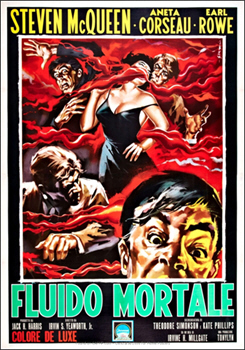
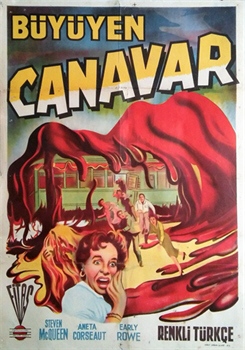
(McQueen did not, in fact, ever call himself “Steven”: that ‘n’ is a typo and it’s not the only one; my guess is that someone read a list of names out over the phone when the titles were being prepared. Anita Corsaut’s surname is misspelled “Corseaut”, Stephen Chase ended up as “Steven” – something about that name! – and Keith Almoney’s first name is given as “Kieth”. Olin Howlin, playing the nameless doomed old man in his final screen appearance, toggled back and forth between “Howlin” and Howland” over the course of his career, so that’s not necessarily a mistake.)
Though it makes for a better story, The Blob was not Steve McQueen’s first film, nor even his first significant screen role; but it was the first that gave him billing. Having seen him on stage in A Hatful Of Rain, when he was understudying Ben Gazzara, and having been equally impressed with his television work, Jack Harris suggested McQueen to Irvin Yeaworth—only for the director to hit the roof. Yeaworth had encountered McQueen before, when working with his first wife, Neile Adams: McQueen made himself so obnoxious around the set that Yeaworth fired Adams to get rid of him.
Duly warned, Harris nevertheless persisted with McQueen’s casting—which indeed proved a mixed blessing. Evidently bent, in the wake of James Dean’s death, upon establishing himself as the cinema’s new “bad boy” (not an assumed persona, given McQueen’s extremely troubled youth), McQueen was doggedly difficult on-set, clashing with cast and crew and insisting on things being done his own way. Apparently he and Anita Corsaut took a particular dislike to one another—and if that is true, it is to both their credits that none of that shows up onscreen: on the contrary, a number of their scenes together are vital in anchoring the film.
Despite everything, Harris and Yeaworth were in agreement that as far as the completed film went, the pain was worth it; and it was Harris who had the last laugh. Offered the choice between $3000 flat for his work or 10% of the gross, McQueen – who expected nothing of the completed film – took the flat payment.


While McQueen’s involvement has ensured The Blob lasting pop-cultural credibility beyond what even its monster provides, his contribution is something of a mixed blessing. Of course we’re all painfully familiar with actors in their twenties being cast as teenagers, but this is a pretty jarring example: McQueen was twenty-eight at the time, and the photography of Thomas Spalding makes no effort to hide the lines on his forehead or the incipient bags under his eyes. Then, too, while there are moments in this film when we can clearly see “Steve McQueen” emerging, particularly during the scene in which Steve and Jane sneak out at night to confront their situation, there are other moments when McQueen remembers he’s supposed to be playing seventeen, and adopts a hunch-shouldered, aw-shucks demeanour that is more than a little wince-worthy.
But there’s no question that McQueen’s performance provides the film with some acting ballast which it very much needs. Aneta Corsaut, who does a good job giving Jane a backbone under her sweetness, went on from here to a solid, long-running television career; and Olin Howlin was a well-established character actor, as was Stephen Chase; but otherwise the cast consists predominantly of semi-amateurs – and outright amateurs – whose awkwardness makes itself felt to the film’s detriment. The welcome exception to this generalisation are all found (a tad ironically in context) under the roof of the film’s police station, where Earl Rowe, John Benson and George Karas make an effective and interestingly contrasting trio. As Lieutenant Dave, Rowe projects an air of trustworthy competence that makes him the perfect pivot-point in the developing crisis.
But all of these people – even Steve McQueen – finally play second fiddle to the Blob itself. Born out of Jack Harris’s desire for “a new kind of monster” – not a guy in a suit, not a puppet – and first conceived by Irvine Millgate as “a mineral monster”, the Blob may not have been quite as original as its creators believed (the British science-fiction film, X The Unknown, from 1956, featuring a radiation-eating sludge-monster, offers an obvious precursor, while the previous year’s The Monolith Monsters may have been an influence too), but its realisation certainly was. Created out of liquid silicone and red food colouring, the Blob is a marvellous contradiction in terms: a formless, faceless lump of goo that nevertheless offers hints of an intelligence, and even a personality. That it is a real substance, and really moving, offers suspension of disbelief a significant leg-up; and while some of the supplementary effects by which the Blob is realised, including via animation and the use of a stand-in weather balloon, are not as convincing, overall the film’s monster scenes have a real and lasting impact.

In truth we do not see as much of the Blob as we would like; but (as with much of The Blob) there was thoughtfulness behind this choice, and not merely a desire to hide an inadequate design or save on costs. There is a lapse in time between each sighting of the Blob, and every time we do see it, it is bigger and redder: the effect is jolting, not least because of the viewer’s growing awareness that the reasons these changes are taking place is because it’s been eating people…
The Blob begins with a classic gambit: a teenage couple out parking. We soon realise, however, that this first date between Steve Andrews and Jane Martin is more than ordinarily uncomfortable, although the reasons for that do not immediately appear. Perhaps both are glad of the distraction provided by a shooting star, unusually large and unusually close, which crashes to earth somewhere nearby. Jane acquiesces in Steve’s desire to go looking for it, and they drive off into the dark roads at the edge of town.
One of the most famous vignettes in 50s science fiction follows, as an elderly man, living alone in a shack, finds a small, stony, crater-covered object which cracks open to reveal a thick, colourless substance. Pressing a stick into the substance, the old man then lifts it up to examine it—shifting the angle of the stick as it begins to slide down towards his hand. But instead of oozing back the substance moves up the stick—rapidly engulfing the old man’s hand. He tries but fails to scrape it off and then, crying out in pain and fear, staggers off into the night.
Steve and Jane are just about to give up their search for the landing-place of the shooting star when Jane cries out a warning. Steve swerves and brakes, then jumps out to check on the person who ran into the road without warning. The old man is babbling incoherently about the thing on his hand, but his need for medical assistance is obvious. The teens bundle him into the backseat of the car and begin speeding back to town. Steve, in his urgency, burns another car off the road. He doesn’t much think about it at the time, but his action will have consequences…

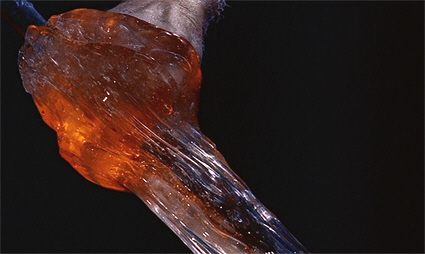
Dr Hallen is just making his final preparations to leave home, to attend a conference, when Steve and Jane carry the old man in. Hallen is somewhat annoyed at first with this interference with his plans, but one look at the thing on the old man’s hand and his professional curiosity is thoroughly aroused. Horrified, Steve insists that the thing has gotten bigger in the time it has taken to bring the old man to town; it has also become a reddish colour…
(In a nice bit of foreshadowing for the film as a whole, Hallen immediately puts the worst construction on his words when Steve tells him that he and Jane “ran into” the old man; though Jane quickly sets him straight.)
As Hallen begins to treat his patient, in the first instance for his evident pain, he asks Steve and Jane to return to where they found him, to see if they can find someone who knows what happened. They agree willingly enough, but are immediately diverted: outside, waiting for them, are Steve’s “frenemies”, Tony, Mooch and Al, who were in the car he burned off, and who now insist on an immediate drag-race to settle the question of supremacy.
Not only with its monster, but with its characterisations, does The Blob separate itself from similar 50s science-fiction films. Like many of its ilk, this is a “the adults don’t understand” story; but here, the screenplay takes pains to forge a détente between the generations. In doing so, it walks a rather amusingly cautious line—on one hand assuring any adult viewers that these kids are good kids, really, who can be trusted to do the right thing despite occasional outbreaks of recklessness or stupidity; and conversely, assuring its teen viewers that while adults may be suspicious and unimaginative by nature, when push comes to shove, they can be trusted, too.
This attitude is in striking contrast with the output of the era’s leading producer of teen-focused films, AIP, who in their pursuit of the teen dollar never hesitated to throw the older generation under a bus; while at the same time, via their juvenile-delinquent films, deliberately fuelling adult fears about the generation gap and “kids today”.

It may well be possible to trace The Blob’s unwontedly optimistic outlook to its unusually conservative background. Irvin Yeaworth was a devoutly religious individual who got his start producing 16 mm educational, religious and otherwise inspirational films, and who worked with a stock crew who shared his beliefs. Screenwriter Theodore Simonson was (I think) a Lutheran minister whose only previous writing experience was in the area of religious essays and similar papers; while co-writer, Kate Phillips, was offered the job by Yeaworth when they met at an International Christian Leadership meeting. (Under her real name, Kay Linaker, Phillips had a Hollywood acting career lasting over two decades.)
Be that as it may, you’ll struggle to find a film of this time more populated by well-meaning people, or more bereft of bad guys. The only character who even remotely fits the latter bill not only has fair reason for his attitude but, by the end, has been forced to change his stance. Otherwise, everyone is on an amusing sliding-scale, wherein Steve Andrews represents the town “bad boy”, and Tony, Mooch and Al are what passes in Downington for “juvenile delinquents”. (You should keep those classifications in mind during the rest of the film.) All this gives the film an air of determined good-nature that, while just slightly absurd, is nevertheless another way in which The Blob stands out from similar productions.
(Just how threatening is this trio of “delinquents”? Note good-girl Jane’s demeanour as they surround Steve’s car, and later when Tony pinches her cheek.)
Steve tries but fails to talk his way out of immediate drag-racing, and so adopts another tactic. With his eye, in the mirror, on the set of traffic lights behind them, about a block up the road, Steve insists on taking Tony’s boast of beating him “backwards” literally. The two cars scream in reverse for a distance, until Steve slams on his brakes; the car driven by Tony careens through the intersection and then is trapped there—because the light is red; and they couldn’t possibly run a red light…


Steve and Jane laugh, but the smiles are wiped off their faces when they are approached by the head of the local police force, who we will know only as “Dave”. (We should note that there’s no lack of respect intended in the kids calling him that; on the contrary.) A lecture follows, during which Dave begins with a threat to call Steve’s father, then abruptly switches to one to call Jane’s father: a threat which carries more weight than we know at the time. In the end, though, Steve is let off with a slap on the wrist.
The other three are waiting up the road for Steve and Jane (I’m not quite sure how they manage that), and we hear about another member of the police force, Sergeant Bert – who, significantly, the kids refer to as “Bertie” and “Bert the Schmert” – and who, the night before, they tricked into participating in a practical joke.
Steve then recalls his mission for Dr Hallen. The others at first refuse to come along, on the grounds of their intention to attend “a midnight spook bit”, but are persuaded they can do both. They find the crater, and what’s left of the meteorite; but there is no-one of whom they can ask questions. Jane does, however, insist on taking the old man’s dog back to town.
Back at Dr Hallen’s, we discover that the substance has by now grown right up the old man’s arm. Hallen calls up his nurse, Kate, asking her to come back to work, because he may have to perform an amputation. She does so, but when asked to check the patient’s pulse, she can’t find him…
Lee Payton as Kate is one of several cast members whose only credit this is, and she’s one of the film’s weak links—particularly the way she stands unmoved at this point, obviously waiting for her cue, and then bleats, “Oh, doctor, I’m afraid!” when she gets it.
On the other hand, this scene offers our first proper look at the Blob as it sits quivering on the surgery floor…

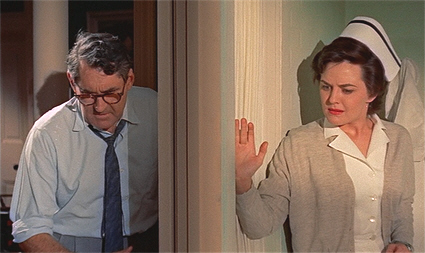
Hallen urges Kate to keep as far away from the thing as possible, while also taking action to, hopefully, destroy it:
Hallen: “Behind you! The trichloroacetic acid!”
(…a very odd acid to choose, and really not one you’d expect to work in this situation: TCAA is often used as a topical medication, for example in chemical peels and as a wart remover [including genital warts!]…)
The Blob flashes yellow for a moment but is otherwise unaffected by its acid bath. Hallen decides to try shooting it (oh, c’mon!), and goes for one of the guns in his den. Kate responds to his urging to stay absolutely still by going into hysterics, backing away and tripping over the stand-light near the surgical table, smashing it – which shorts the lights – and falling to the floor. By the time Hallen gets back with his shotgun, there’s no sign of her…
The Blob – larger now – rolls into the doorway. Hallen puts two rounds into it, but of course to no effect. He flees, locking himself into his den, and picking up the phone to call for help…
When Steve and Jane arrive back, all is dark and quiet at the doctor’s house. Steve gets out of the car, leaving Jane nursing the dog, and goes up to knock. There’s no answer. Puzzled, Steve continues to wander around the house, looking for signs of someone there—
—and goes around the corner just in time to catch a glimpse, through a window, of Dr Hallen being engulfed by…something…
(In fact what we see does not match Steve’s description of it, which is much more graphic and disturbing. Perhaps the film-makers did not want anything too explicit, but hoped that the viewer’s mind would nevertheless “see” what they wanted.)
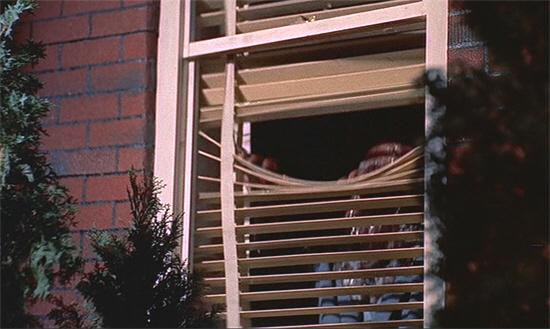
Thoroughly frightened and upset (and it is a credit to both the film and to Steve McQueen that there is never any soft-pedalling of Steve’s terror), Steve rushes back to the car, alarming Jane. He is quick to put two and two together, identifying the thing on Dr Hallen with the goo on the old man’s hand, despite its altered size and appearance, and decides on immediate action:
Steve: “We’ll go to the police. They’ll know what to do.”
Name one other screen teenager of this era who ever said THAT?
The scenes at the police station are some of my favourite non-monster ones. The level-headed Dave is supported by the irascible Sergeant Bert and the slightly hang-dog Richie (who gets the midnight-to-dawn shift, and passes his time playing radio-chess with another, similarly circumstanced, officer in another town), and the three men together make for a credible professional unit. It helps that these scenes were almost certainly shot at a real local police station: it is both too cluttered, and too detailed, I think, to be a set.
Steve comes rushing in with his wild story of Dr Hallen being killed by “this thing”. The suspicious Bert immediately takes this as another practical joke. Dave, though willing to give Steve some benefit of the doubt, is understandably unconvinced by the story he hears; but since a death has been reported, he agrees to look into it.
The investigation into Dr Hallen’s death is a cleverly constructed sequence, with circumstances conspiring to undermine Steve’s claims at every turn. Dr Hallen, as you may recall, was on his way out when Steve and Jane arrived, and the house reflects this: it is dark and quiet, there’s a note on the door explaining the doctor’s absence, and his officious neighbour / housekeeper, Mrs Porter, comes barging in to announce that, to her certain knowledge, Hallen left town earlier in the evening (because he phoned her and told her he was “just on his way out”).
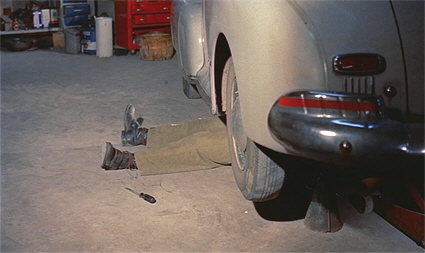

On the other hand, the doctor’s den is a wreck; it contains a recently fired shotgun; and it’s locked on the inside. But Bert isn’t having any:
Bert: “It’s part of a plan to make us look silly!”
Jane: “I think you’re doing a good job of that on your own, sergeant.”
Bert is more and more convinced that Steve is playing an elaborate practical joke, particularly after hearing that earlier in the evening he was in company with Tony, Mooch and Al—who, as you might recall, pranked him the night before. Steve can only admit that he doesn’t know where the doctor is – or the old man – or “the monster”…
We know, though: it’s downtown, at a garage, having a midnight snack…
Back at the police station, Steve is futilely protesting the calling of his and Jane’s respective fathers. Mr Martin immediately reveals himself as a fuss-budget, stick-up-the-butt type—and as the high-school principal.
The insistence that girls prefer “bad boys” to decent guys is an exasperatingly thoughtless generalisation (of course, most generalisations are), but there’s certainly a whiff of this in Jane’s relationship with Steve—and that’s okay, because instead of just letting it sit there, the film does something with it. It can’t be easy being the principal’s kid, still less one like Mr Martin, who we don’t doubt causes his daughter a great deal of social grief. It is easy to read Jane dating Steve not as evidence of her taste for “bad boys” per se, but as a passive-aggressive hit at her father; and Steve’s interest in her, likewise, as a chance to annoy the principal—with whom we’re quite sure he has had numerous clashes in the past. Hence the awkwardness of the opening scene between them: neither one of them is on this date for the right reasons and, had circumstances been different, probably their first date would have been their last; but the developing crisis allows each of them to see the other in a new light.

Mr Martin, after bewailing the damage done to his reputation when word gets out that he had to collect his daughter at the police station, lays into Steve, sure that it’s all his fault…whatever “it” is. The quiet, level-headed Mr Andrews, on the other hand (who, in a nice touch, come in with his suit mis-buttoned, sign of hurried dressing), sticks up for Steve’s honesty; which prompts Jane, too, to appeal to him for support; though she has to admit that she did not actually see what happened to Dr Hallen.
Dave suggests letting things ride for the night, until they succeed in contacting Dr Hallen or his colleague and presumed travelling companion, a Dr Gilpin, and sends everyone home. Under cover of the police officer reassuring the two fathers, Steve has a quick, quiet word in Jane’s ear…
Sergeant Bert checks in, but has nothing more to report than a couple of neighbours who may have heard shots. He is looking forward to making the kids talk, however—and is not best pleased when Dave tells him he let them go home. His response makes Dave angry in turn, and in blowing off steam to Ritchie, he lets us know the root of Bert’s issues with the teenagers: that his wife was killed in a car-crash-caused by a young driver. His attitude is therefore not surprising; however—
Dave: “That doesn’t make it a crime to be seventeen years old!”
Having both, supposedly, settled down for the night, Steve and Jane sneak out of their houses. We get the impression Steve is a lot more practised at this than Jane: he climbs out of his bedroom window, she slips down the main stairs—and is caught by her very young brother, Danny, who takes some shaking off. (A painfully bad young actor, too: okay, it’s not his fault; but he certainly shouldn’t have been given so much dialogue.) The teens meet up and slip under the trees on the far side of Steve’s house.
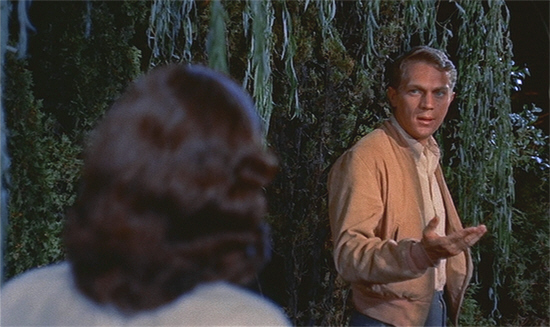
This is an important and well-played scene, with Steve trying to convince himself he didn’t see what he did see, and Jane having none of it. Of course, it isn’t just a matter of an incredible story: if there is a monster on the loose, killing people, then the responsibility for doing something about it rests squarely on Steve. But even so, even if he’s willing to take on that responsibility, what can he do if no-one will believe him?
No adults, anyway: it is Jane who suggests calling in “the kids”.
The most famous scene in The Blob (we’re not quite there yet, but bear with me) takes place in the Downington cinema—played by the Colonial Theater in Phoenixville, Pennsylvania. Producer Jack Harris slips in a couple of in-jokes here: in the first place, the “midnight spook bit” is a showing of John Parker’s maddening but intriguing 1953 film, Daughter Of Horror (aka Dementia), which Harris himself distributed; we may perhaps read his opinion of it in that most of the (mostly) young audience is seen laughing at it. The supporting feature, indicated on the marquee only as featuring Bela Lugosi, is a non-existent film called The Vampire And The Robot (“More horrifying than ‘Dracula’!”), whose mock-up poster is an obvious riff on the famous one for Forbidden Planet. At this time Harris had just bought the American rights to poor Bela’s 1952 “comedy”, Mother Riley Meets The Vampire, which he intended to release under the faux-title used here, but as things eventuated it didn’t appear until 1967, and then it was as My Son, The Vampire.
Inside—well, I’m guessing there’s not much to do in Downington, because the Colonial Theater is very crowded for its midnight screening. Steve and Jane slip up into the balcony and finally persuade the three boys, plus a fourth, unnamed one, and two unnamed girls, to follow them outside. This little scene allows for another in-joke: the elderly gentleman sitting behind the teens, who shushes them as they argue, is played by Theodore Simonson.


Meanwhile, Sergeant Bert arrives back at the station with an odd story to tell about a bar downtown, with its lights on, the TV playing, the cash register intact—yet completely deserted…
This blends into another intriguing touch in the film, as the teenagers conduct a futile door-knocking campaign to warn people. Two of them end up glimpsing a raucous adult party, with booze flowing; others make no headway at (another) bar. This tacit criticism of the town’s adults and their drinking habits (you just know these kids never downed anything stronger than an ice-cream soda) is one of the film’s few overt instances of “taking sides”.
Steve and Jane, driving through the town, spot the old man’s dog (which escaped Jane at Dr Hallen’s house) outside the market owned by Steve’s dad. Steve is concerned when he finds that the market has not been locked up for the night, yet there is no sign of Mr Windemeyer, who sweeps up before closing. Carefully, Steve and Jane look around—and find what they’re looking for. The two run for the store’s back-doors, but they are chained shut, and they are forced to take refuge in the cold-storage room instead. They watch in terror as the Blob begins to ooze under the door—and in puzzled relief as it withdraws itself; although Jane shudders as a terrifying yelping is heard.
(Jane’s ongoing wailing about “the little dog” gets annoying, but let’s be honest: in her shoes I’d be doing exactly the same thing, so I can hardly criticise. And frankly, I’m kind of impressed that she keeps it up in the face of the evidence that poor old Mr Windemeyer has been blobbed.)
After a time, the two cautiously make their way back out into the store—and dash for the front doors just in time to meet up with their friends. Believing that the Blob is still inside, Steve runs for a phone—but then hesitates, remembering that he’s supposed to be at home in bed. He makes Tony call the police station, but alas, Dave had departed for the night; and Tony gets his head bitten off by Sergeant Bert: “Is every kid in town in on this!?”
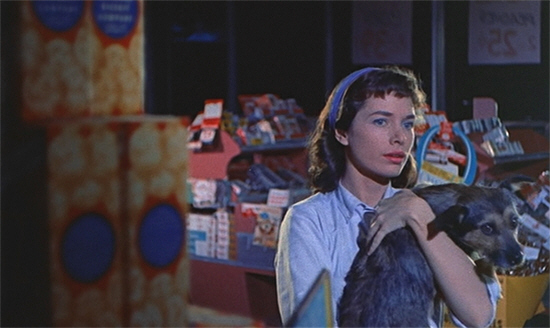
“The right way” having failed, the kids adopt the wrong way; and soon a mixture of car horns, fire alarms and even an air-raid siren is bringing the town running—including, thankfully, Dave. The gathering crowd also includes Mr and Mrs Martin, who have just discovered that Jane is missing.
Caught between Steve and Sergeant Bert, Dave compromises by telling the agitated crowd that while there is “an emergency”, the police have it under control; he encourages everyone to leave. As the townspeople disperse, Dave makes plans to search the market—only for the cynical Bert to appear through the front doors, having taken upon himself to disprove Steve’ story. He announces in an arid voice that there’s no monster in the store.
Of course not. It’s at the movies.
And now it’s time for that most famous of scenes, as the Blob first oozes its way through a grate into the projection-room of the Colonial Theater – taking out the unfortunate projectionist – and then through the booth’s glass windows, into the cinema itself…
(In spite of the dubbed-in screaming, the extras in this scene, local teenagers for the most part, look gleeful rather than scared as they do this famous run; and such is also true of Jack Harris, who has his own cameo here.)
As Steve desperately defends his actions, there comes the sound of screaming from down the block—as terrified movie-goers flee for their lives and stampede out into the streets, running for their lives.
Dave fights his way upstream and into the cinema—and quickly emerges again, white-faced:
Dave: “It’s the most horrible thing I’ve ever seen in my life!”
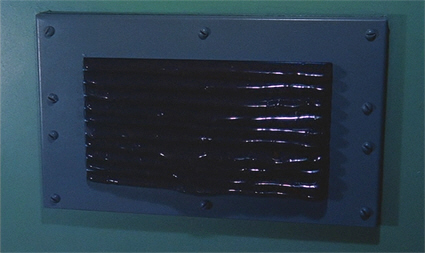

As everyone but emergency services – and the kids – clears the area in a panicked rush, the Blob rolls out into the street. The thing is now enormous, almost as high as the cinema-building itself; we gather it fed well inside.
Aaaaand obnoxious young Danny Martin chooses this moment to put in an appearance (though how he got there at all, let alone behind the diner [?] is a mystery), causing Jane and Steve to swoop in and lift him to safety inside the diner; relative safety; temporary safety. In response, the Blob lifts itself and engulfs the entire diner…
(Doesn’t its doing so, instead of hunting the milling crowd, suggest the ability to make choices?)
As Steve wrestles with the diner’s confused owner, to prevent him from going outside, the phone rings. It’s Dave: he explains his plan to drop a powerline onto the Blob; though he admits he isn’t sure the thing can be killed. He tells everyone to take refuge in the cellar, and Steve passes the order on; dropping the phone, not hanging up.
It’s Sergeant Bert – who we learn along the way has an impressive war-record (something he concludes gloomily does him no favours with this post-Korea generation, though in that he does the kids another injustice) – is given the task of bringing down the line. He does so as planned, but the electrical current has no more effect on the Blob than the acid did earlier, and the only thing they achieve is to set the diner on fire—and they can’t put it out because it’s under the Blob.
Trapped now between the Blob oozing down the stairs and through the basement windows, and the growing smoke and fire, Steve and Jane exchange a look of despair; but they concentrate their efforts on trying to keep Danny from understanding what’s going on. The diner-owner is still more intent upon his property than the Blob, and grabs up a CO2 fire-extinguisher, spraying it at the flames—
—and the Blob recoils.
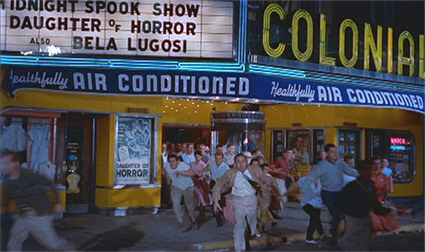

Seeing this, Steve remembers the Blob’s retreat from the storage-room at the back of the market:
Steve: “Cold! That’s it! It can’t stand cold!”
Having run out the one extinguisher, Steve shouts desperately up the stairs, towards the still-open phone-line. His message is caught by Ritchie, who passes it on; but the fire-chief responds that there are only a handful of CO2 extinguishers in town.
And then—it’s Mr Martin to the rescue! He knows were there are many such extinguishers: at the high-school! The kids speed off to collect them all, Mr Martin piling into Tony’s car without hesitation. Still more remarkably, Sergeant Bert climbs into one of the others. However, when they get to the school, they find the doors are locked—and Mr Martin doesn’t have his work-keys with him.
But Mr Martin is not to be thwarted! He picks up a rock and smashes a pane in the glass doors, as the kids cheer.
(We might wonder whether, after this act of vandalism, Mr Martin was less or more able to maintain school discipline. Given these kids’ track-record, I’m guessing ‘more’.)
The group collects all the school’s extinguishers and rush back to the scene of crisis. They turn them on the Blob, which retracts, and shrinks, and finally is frozen solid. Meanwhile, Ritchie has gotten onto Washington, and although it takes a while for Dave to convey the situation (someone, maybe General Mark Grayson – or maybe Commander Jack Rankin – wants to blow the Blob to pieces!), finally he arranges for a military transport plane to collect the monster, fly it to the Arctic, and drop it there:
Dave: “I don’t think it can be killed. But at least we’ve got it stopped.”
Steve: “As long as the Arctic stays cold.”
Yeah.
Thanks for that thought, Steve.


The Blob, in the end, is a film greater than the sum of its parts. It is easy enough to finds flaws in it – the sometimes ropy acting; the lack of tension in Irwin Yeaworth’s direction, which dissipates suspense; the inadequacy of some of the effects – yet in its entirety it is a fun yet oddly thoughtful and heartfelt addition to the marvellous dossier of 50s science-fiction films.
Much of this we must credit to Jack Harris, in his determination to “do something different”. To say the least, he succeeded. It is precisely the film’s differences that keep it engaging. Consider this: there is no explanation at all offered for the existence and behaviour of the Blob – no hint of its origins, or how it got inside that meteorite – no scientist butting in with his theories (or trying to save it for SCIENCE!!). Nor, the film’s last shot notwithstanding, is there any military presence. This was one of the things Jack Harris really wanted: a monster which would pose a serious threat to mankind, yet be capable of being defeated by small-town America. That we do not miss the film’s absent tropes speaks for itself.
While some of this film was shot at the Valley Forge Films studios in Pennsylvania, it is the location shooting and its consequent verisimilitude that gives The Blob so many unexpected touches of realism. (And ‘realism’ was another thing Jack Harris wanted.) The diner that appears in its famous climax really was in Downington – and, being emblazoned as such, meant that the in-film town had to be called “Downington”, too (it still exists, but in another town, evidently); the supermarket where the Blob traps Steve and Jane in the cold-room was in Royersford; while the high-school, like the Colonial Theater, was in Phoenixville.
And the Colonial Theater, I’m delighted to report, is not only still in existence, but underwent restoration some twenty years ago. There is now a commemorative plaque in its projection-booth, marking one of The Blob’s most memorable moments. And, most importantly of all, in the year 2000 the Colonial Theater began to host an annual “Blobfest”, which was always attended by a very special guest…
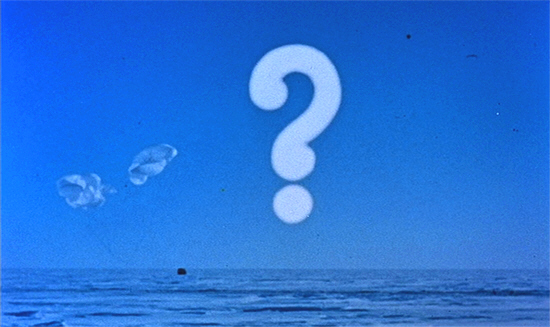
In 1965, film fan Wes Shank toured Valley Forge Films and met Irwin Yeaworth there—and learned to his astonishment that the Blob was still in existence, in a sealed five-gallon drum that Yeaworth kept at the studio. Delighted at first just to be given a small sample in a jar, Shank became obsessed with the idea of owning the Blob. At length, his persistence on the subject wore Yeaworth down, and he sold the Blob to Shank, along with the scale model of the Colonial Theater used in the film.
Mindful of his responsibilities, every year Wes Shank made sure that the real star of The Blob (no offence to Steve McQueen, but let’s be realistic…) attended Blobfest where, in addition to watching the film in its natural habitat, and being invited to participate in a re-enactment of the famous stampede into the streets, attendees got to see the actual Blob; although not, I’m somewhat sad to say, to poke it with a stick.
But perhaps it’s for the best…
You’ll find the lyrics of the theme-song over in Immortal Dialogue.
Want a second opinion of The Blob? Visit 1000 Misspent Hours – And Counting.
♦♦♦♦♦♦♦♦♦♦♦♦♦♦♦♦♦♦♦♦♦♦♦♦♦♦♦♦♦♦♦♦♦♦♦♦♦♦♦♦♦♦♦♦♦♦♦♦♦♦♦

This review is part of the B-Masters’ tribute to movie music!

This movie scared the hell out of me when I was a little kid, often keeping me up a night or two after seeing it. But damn if I didn’t watch the thing whenever it turned up on TV. I love that it got the Criterion treatment.
LikeLike
This sort of thing gets at me, too (though it isn’t fear of absorption so much as fear of suffocation). Have you read Joseph Payne Brennan’s short story, Slime? That scared the hell out of me at a formative age. 🙂
LikeLike
I’m not sure if its the same story, I read a short story about a deep sea blob-like creature that was washed into a woodland by a tidal wave, which oddly did no other damage and no-one was aware of it, It was only affected by light and had the scariest scene of one of its victims being completely surrounded by the creature and holding it off only by the light of a dying flashlight. *shivers*
LikeLike
That’s the one. They can’t see it coming in the dark, they can only smell it…
LikeLike
No I haven’t and it’s probably too late now. Sad to say that while I still enjoy monsters my fear of them has passed with my youth.
LikeLike
Dunno. I re-read not so long ago and it’s still pretty damn creepy (if a bit overloaded with adjectives).
LikeLike
Have you seen “The 4D Man” by the same producers? It’s a nice and creepy sci-fi film that I think still hold up.
LikeLike
I haven’t, but I have a copy somewhere. I was thinking I need to dig it out.
LikeLike
I should try to find that short story…
I, too, got spooked by this movie at a young age. Much like Steve, I convinced myself I hadn’t seen what I thought I had with the doctor’s demise, but the projectionist getting it absolutely terrified me: the POV shot of it rearing up and then lunging at the camera; him being engulfed, completely helpless to stop it…I think the worst part was him not even having the chance to scream, but dying in complete silence, unable to warn anyone. *brrrrr*
This used to be my favorite movie song*, but I think The Green Slime‘s has taken that spot. Might be due to my appreciation for acid rock as I got older. Still, it’s a close-run thing, and I might very well decide whichever one I’m hearing at any given moment is my favorite.
*Not counting instrumental pieces, in which case the Puppet Master one would win.
LikeLike
Thanks to you, I’m now obsessed with Joseph Payne Brennan’s stories. 😀
LikeLike
Thanks to this post, I’ve since become a huge fan of Joseph Payne Brennan after seeking out that story. 😀
LikeLike
It really needs to be on the Library of Congress’ National Film Registry, too. I keep forgetting to nominate it, though.
LikeLike
I have to say that of all the monster movies I’ve watched, the Blob is the one monster that most got to me and was the nightmare fuel that fed my still occasional fear of the dark. A silent, creature that can slip through the cracks into any room to get you was just scarier than hell to a kid’s mind.
I first saw it in the sequel, Beware! The Blob, aka The Movie that JR Shot.
LikeLike
I’d say The Blob was the movie that scared me most when I was a child with Invasion of the Body Snatchers (50s version) as a not too distant second. When I first saw The Blob I put on a night light in my bedroom but in hindsight that only made it worse. The dim light only accentuated the shadow at the bottom of my bedroom door which, of course, I stared at throughout the night.
LikeLike
I love B movie music and both The Blob and The Green Slime themes. I can say with certainty they are both in a top list of mine. There are so many. If I had to pick a single theme as a favorite, I think I would go with the one from a movie I hope nobody else here has bothered with.
Nudist Colony of the Dead! (Dead.Dead.Dead.)
Better go to church insteaaadddd!
Than the nudist colony of the dead!
LikeLike
Great review, Liz. What’s your take on the 1988 remake? I sort of like it even more than the original.
LikeLike
You KNOW I’m not going to like the remake better! 🙂
It’s fine in its own right, although the Blob’s origins are disappointing.
LikeLike
I agree while it was nice to see what they could do with newer special effects, the entire origin plot in that movie felt so unnecessary to me. Why can’t we just let the monster be the monster?
LikeLike
“He knows were there are many such extinguishers: at the high-school!”
Tragically, this was in the same general timeframe as the flashback in Treehouse of Horror VI: “Nightmare on Evergreen Terrace”…
D’OH!
LikeLike
I must have been 10 or 11 when I first saw this movie, and I thought I was a pretty tough guy. When the Blob leapt up the stick onto Olin Howlin’s hand, and Howlin started to scream, I was not so tough.
LikeLiked by 1 person
While the sequel, “Beware! the Blob” AKA “Son of Blob” is execrable, it does have one amazing moment. I suspect it was inspired by the movie theater scene. The Blob invades a bowling alley and gets behind the pin setting machines. With the magic of special effects and an undercranked camera, the creature LUNGES up the alleys at comparatively high speed. Shocking, again when I was young.
LikeLike
“Inside—well, I’m guessing there’s not much to do in Downington”
It was 1958. It’s my understanding that there wasn’t much to do anywhere…
BTW, did you know that 1958 was the general timeframe of the 2nd half of the third season and the 1st half of the fourth season of Happy Days? Didja, huh, didja, didja? 😉
LikeLike
Many years I ago I knew Al Hillmann, who edited The Blob. His wife, Michael, told me she had to keep the Blob in her refrigerator during production. That probably would have been pretty cool if they’d held a party….
LikeLike
Gives a whole new meaning to the concept of jello shots…
LikeLike
I think I have read that story (“Slime”) if it has a scene where the authorities are asking a girl what happened to her boyfriend and she screams hysterically “The darkness came alive !”
LikeLike
That’s the one. 😀
LikeLike
Don’t forget the contributions of Russell S. Doughten Jr., another member of the Good News Productions staff, who eventually pulled up stakes and moved from Pennsylvania to Iowa, where he developed and filmed his fanatical Rapture Quadrilogy starting with A Thief in the Night (1972). Followed by A Distant Thunder (1978), Image of the Beast (1980) and The Prodigal Planet (1983), which, essentially, was The Left Behind series before The Left Behind Series was cool. Also, a lot of head chopping.
http://microbrewreviews.blogspot.com/2011/05/youtube-finds-its-end-of-world-as-we.html
LikeLike
Like a lot of commenters here, the Blob terrified me as a kid, but in my case it was before I actually saw the movie! I had seen clips of both The Blob and Beware! The Blob at a very young age and my mother explained the basic plot, and that was enough. I eventually saw it when I was a little older, and while the fear had faded, it lingered for a few years more before being replaced by a fear of zombies after looking at the VHS box of Day of the Dead.
I’m so glad to see Brennan’s “Slime” mentioned here! I read that a little after my Blob fear left and loved it. There’s also Theodore Sturgeon’s “It”, although that’s more of a killer plant story.
Something amusing: Japanese superhero show Tenso Sentai Goseiger (2010) has a wicked monster named McQueen the Blob.
LikeLike
Hi – welcome!
Your story puts me in mind of Will Laughlin’s about how he was terrified as a child by Octaman, after catching just a bit of the movie. Things like that can leave deep scars, I know! (I’d be too embarrassed to tell you the movies that succeeded in terrifying me into nightmares…) Meanwhile, Slime never stopped being scary…
Aww, that’s so cute! 🙂
LikeLike
Two thoughts about The Blob as it is on TCM now.
1). Hey, anyone can mention sulfuric, nitric or hydrochloride acid! Let’s give ‘em an acid that movie Science! never uses. Trichloroacetic acid in its finest film moment.
2). If the adults were right about the pesky teens, considering the town in which they live it would indeed make them Johnsonville brats. Surprising that the marketing campaign for sausage hasn’t taken advantage of this.
LikeLike
Like most people commenting here, I was terrified by this film when I was little. All I remember is it climbing onto the old man’s hand, and being scared for the dog afterward. Never watched it since!
LikeLike
It’s interesting how much more scary a lot of people find this than a lot of films that were really meant to be scary! 🙂
LikeLike